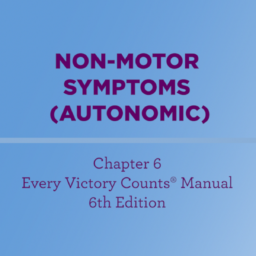Some non-motor symptoms you may experience with Parkinson’s are connected to the effects Parkinson’s has on your autonomic nervous system, which automatically regulates your body’s functions. Two of these functions are urination and defecation, and Parkinson’s can cause complications with both. These complications can, in turn, lead to pelvic floor dysfunction, a condition underreported and undertreated among people with Parkinson’s.
Although pelvic floor dysfunction is common and can negatively impact your quality of life, it can be managed and prevented when you know the symptoms and treatment options. This post will help you do just that, highlighting the signs of pelvic floor dysfunction, common causes, and risk factors, as well as the treatment options available so that you can manage your pelvic floor health and live well with Parkinson’s.
What is your pelvic floor?
Your pelvic floor is a group of muscles, ligaments, and tissues found on your pelvis’s floor (base). Your pelvis is home to organs including the bladder; urethra, uterus, and vagina (in women); prostate (in men); small bowel; and rectum. The pelvic floor muscles serve as the foundation or support for these organs. As you feel the urge to urinate or have a bowel movement, your body tightens and relaxes its pelvic floor muscles, allowing that process to occur.
What is pelvic floor dysfunction?
Pelvic floor dysfunction is a common condition in which you cannot relax and coordinate the muscles in your pelvic floor to urinate or have a bowel movement. Instead of relaxing when you need to use the bathroom, your body keeps tightening the pelvic floor muscles, making it difficult to have a bowel movement or urinate. This muscle tightening can also cause urine or stool leaks. In some cases, pelvic floor dysfunction leads to pelvic organ prolapse, when your rectum or bladder bulges and/or drops from its usual place in your body.
Pelvic floor dysfunction is more common among women than men; estimates show that one in three women will experience a pelvic floor disorder in her lifetime.
What are the symptoms of pelvic floor dysfunction?
Symptoms can differ depending on the sex of the person experiencing pelvic floor dysfunction. In general, however, common symptoms include:
- Leaking stool or urine (incontinence)
- Painful urination
- Frequently and urgently needing to use the bathroom
- Constipation
- Straining or pushing to pass a bowel movement
- Lower back pain
- Frequent pain or pressure in your pelvic region, genitals, or rectum
Women who experience pelvic floor dysfunction may feel pain during sex, and men with the condition may have problems having or keeping an erection (otherwise known as erectile dysfunction or ED).
What causes pelvic floor dysfunction?
Factors that can cause or worsen pelvic floor dysfunction include:
- Genetics. For some people, pelvic floor dysfunction is a hereditary condition. Researchers are currently investigating potential genetic causes of pelvic floor dysfunction.
- Pregnancy and childbirth. Pelvic floor dysfunction is common after giving birth because your pelvic floor muscles and tissues can become strained during pregnancy and during a long or difficult labor.
- Interstitial cystitis. This chronic bladder condition involves long-term inflammation of the bladder wall. It can cause pain in your pelvis or bladder, which can cause pain in your pelvic floor muscles and lead to pelvic floor dysfunction.
- Constipation. Research suggests that up to 50% of people who experience chronic constipation also have pelvic floor dysfunction. Studies have also shown that nearly 80% of people with Parkinson’s experience constipation since Parkinson’s impacts on the autonomic nervous system can slow the movement of food through your gastrointestinal tract. In addition, studies have found that pelvic floor dysfunction itself is the cause of constipation in many people with Parkinson’s. These studies help explain why it’s likely that you will experience both constipation and pelvic floor dysfunction when you’re living with Parkinson’s
- Obesity. Obesity is associated with a high prevalence of pelvic floor disorders, including urinary and fecal incontinence and sexual dysfunction.
- Aging. Studies have shown that aging increases the risk of experiencing pelvic floor dysfunction (especially fecal and urinary incontinence), but pelvic floor dysfunction is not considered a typical sign of aging.
- Neurological conditions, including Parkinson’s. Your nervous system plays a role in the proper functioning of the pelvic floor, so conditions that impact that system, such as Multiple Sclerosis, Parkinson’s, or stroke, can cause problems with urination, bowel regulation, and other symptoms of pelvic floor dysfunction.
- Surgery. Some surgical procedures, including pelvic surgery or radiation treatments, can increase your risk of experiencing pelvic floor dysfunction if the procedure damages nerves and other tissues of the pelvic floor.
- Heavy weightlifting. The repetition of lifting heavy weights can cause pelvic floor dysfunction, especially if you have other risk factors.
How can you manage pelvic floor dysfunction?
The good news is that pelvic floor dysfunction can be managed and prevented with treatment. Here are a few actions you can take if you experience symptoms:
- Work with a physical therapist (PT). The most common treatment for pelvic floor dysfunction is biofeedback, which is done with the help of a PT. Biofeedback is a non-pharmacological therapy that helps you “retrain” your muscles or regain control over certain bodily functions. During this therapy, your PT may use special sensors and video devices to monitor your pelvic floor muscles as you try to relax or tighten them. This helps your PT better understand what’s causing the muscles not to work correctly and personalize a treatment plan to help you improve your pelvic muscle coordination.
- Practice regular Kegel exercises. A PT can also teach you the proper way to do Kegel exercises, a powerful way to minimize pelvic floor dysfunction. These exercises, which you can do anywhere, involve tightening your pelvic muscles for three to five seconds and then relaxing the muscles for three to five seconds. Building Kegel exercises into your daily routine can help you manage and prevent pelvic floor dysfunction.
- Minimize constipation. If your medication regimen includes drugs that can increase constipation and it’s a symptom you frequently experience, talk to your doctor about possible adjustments that might help. Eat foods high in insoluble and soluble fiber, which work together to make your stools larger, softer, and capable of passing smoothly through your bowels. Drink plenty of water. Also, as we recommend, exercise daily as it increases your heart rate and gets your blood pumping quickly, stimulating the intestinal muscles and helping relieve constipation. An excellent aid if you have trouble with constipation is the squatty potty. You can even get a discreet portable one if you spend time on the road or in hotels.
- Visit a urologist or urogynecologist. A urologist is a medical doctor specializing in conditions affecting the urinary tract and reproductive system. A urogynecologist is a medical doctor with special training in urology and gynecology (the field of medicine that involves the treatment of women’s diseases, especially those of the reproductive organs). These specialists can diagnose and treat pelvic floor disorders and advise you on ways to prevent pelvic floor dysfunction in the future.
- Consider surgery. Surgery is not often needed to treat pelvic floor dysfunction. However, if it leads to pelvic organ prolapse—when one or more of your organs in the pelvic area drop from their normal position due to a lack of strength of the supporting pelvic floor muscles—you might need surgery to repair the condition. Surgery may also be recommended if your symptoms include ongoing stress incontinence (when you leak urine while sneezing or coughing) or urge incontinence. Surgical procedures for these symptoms are often minimally invasive. They can include transvaginal slings, fascial slings, collagen injections (for stress incontinence), and Sacral Nerve Stimulation (an outpatient procedure that involves electric stimulation of the sacral nerves that impact your bladder, urinary sphincter, and pelvic floor) for urge incontinence.
The key to minimizing pelvic floor dysfunction is to take action. While it might feel embarrassing to discuss symptoms of pelvic floor dysfunction with your care team, it’s essential to be open and honest about your symptoms and their impacts on your life. Many pelvic floor dysfunction symptoms are easy to treat, but only if your providers know about your symptoms. Speak up, ask for referrals, and get the help you need to manage this symptom and live well with Parkinson’s today.
Additional Resources
What You Need to Know about Urinary Tract Infections (UTIs) and Parkinson’s
Urinary Dysfunction and Parkinson’s
Tips for Alleviating Bowel and Urinary Dysfunction in Parkinson’s
Parkinson’s Medication Guide: Overactive Bladder
Are you looking to learn more about Pelvic Health?
We are hosting a webinar on Pelvic Health and Living with Parkinson’s with Michelle Spicka, DPT, on Tuesday, September 20, 2022, at 1 pm MDT (12 pm PDT, 2 pm CDT, 3 pm EDT). If you would like to join us, please register here.

















